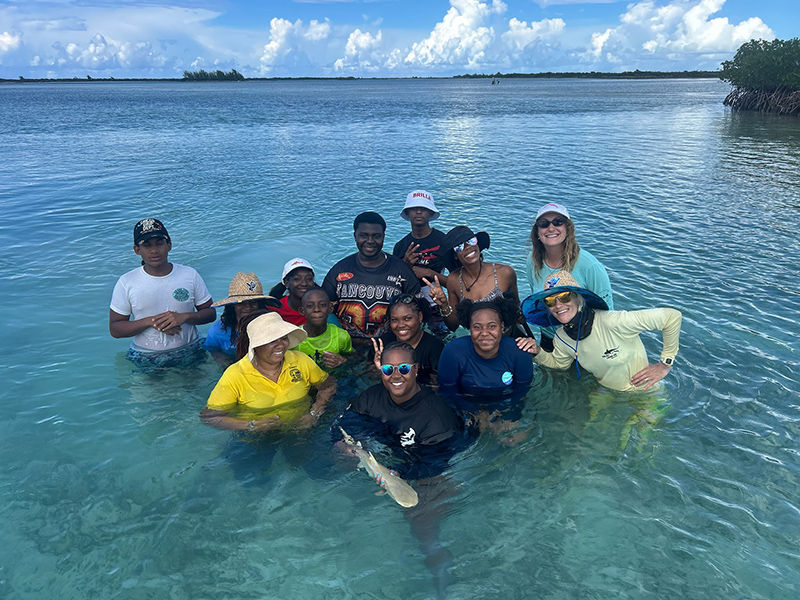10 Facts We Bet You Didn't Know About Sharks
- Sharks4Kids

- Mar 14, 2022
- 4 min read
Author: Marissa DeBonis
1. There are sharks in waters all around the globe
From the frigid arctic waters, to the depths of the sea, mangroves, and even in rivers, sharks can be found in waters all around the planet! There are over 500 different species of sharks that we know about. They range in size from 6 inches to 50 feet in length. Most shark species are actually quite small, averaging just over 4 ft long.

2. Sharks Can Have Friends- Just Like Us
Some shark species are solitary, meaning they like their alone time, and others prefer to be social. A scientific study done in Bimini, Bahamas showed us that juvenile lemon sharks like to spend more time with certain individuals of the same size, even though those individuals are not related to them. They can even learn behaviors from one another, just like how we learn from one another when we go to school as kids.

Lemon Sharks in the mangroves Credit: Jillian Morris
3. Sharks eat their veggies, too
Although most shark species are carnivores, some species get their fair share of veggies in their diets too! Bonnethead sharks (Sphyrna tiburo), a small member of the hammerhead family, like to munch on, and can efficiently digest, seagrass. It can account for up to 62% of their stomach content! Sounds like a delicious side to their crustacean and mollusk filled menu. ( FULL ARTICLE)
4. Scientists can count the rings of a shark
Have you ever heard that you can figure out the age of a tree by counting the rings on the stump? One of the ways that scientists are able to figure out the age of a shark is by using a similar method and counting the rings in the shark’s spinal vertebrae. The ring patterns, in both sharks and trees, is a result of seasonal changes in resource availability, which affects its growth patterns.
5. Some sharks can glow-in-the-dark
Some sharks have the superpower of being able to light up, and others can absorb light and reemit it as a different color! Swell sharks are one of the shark species that can glow. They have a special protein that glows green when activated by blue light. Velvet belly lantern sharks can glow using photophores, which are light producing cells on their belly. These glowing sharks are usually deep sea species that use their superpower to communicate with other sharks or attract food.

6. Sharks can have belly buttons
Sharks can give birth to their offspring in multiple ways- by producing egg cases, giving birth to live young, and even by cloning themselves! When sharks give birth to live young, the young are either supported in the womb with an egg sack that they get their nutrients from or they are connected to their mother with an umbilical cord- like us! When a shark gives birth to her babies and the umbilical cord is broken off, baby sharks are left with a small scar where the cord was attached, or a temporary belly button!
7. Some sharks will return to the location where they were born to give birth to their young
Talk about having a good memory! You may have heard of salmon or sea turtles returning to the location where they were born to give birth, but sharks do so as well! Some species of sharks, like lemon sharks, instinctually will return to the location that they were born to pup. In Bimini, Bahamas, female adult lemon sharks return to the place of their birth every other year to give birth to their young sometime between early February and late May.
8. Hammerheads have a 360 degree view of the world
Because of the location of their widely set eyes on either side of their head, or cephalofoil, hammerhead sharks have a full 360 degree view of the ocean around them while sweeping their heads from side to side while swimming. In addition to a great field of view, the Great hammerheads’ very wide head provides them with more surface area for electroreceptors (Ampullae of Lorenzini), which enhances their ability to find prey, like stingrays!

9. The shark tooth fairy is extra busy
If you took a look inside a shark’s mouth, you would see rows and rows of teeth. When a shark loses a tooth, the next tooth in line will come and take its place. On average, sharks lose about 1 tooth per week for their whole lives! That's over 30,000 teeth in their lifetime. New teeth are always being made, so they will never run out. If there was a tooth fairy for sharks, they would be extra busy.

10. As if sharks didn't have enough teeth already…
Sharks do not have scales like bony fish do. Instead they have skin made out of many small teeth, referred to as dermal denticles. Each shark species’ dermal denticles have varying structures depending on the shark's adaptations- nurse sharks’ are thick and tough to protect them from rock and coral structures, while makos’ are streamlined to allow them to move quickly through the water. The tips of these denticles face the tail of the shark, so shark skin will feel rough from tail to head, but smooth from head to tail.

References
Leigh Samantha C., Papastamatiou Yannis P. and German Donovan P. 2018. Seagrass digestion by a notorious ‘carnivore’Proc. R. Soc. B.2852018158320181583





















